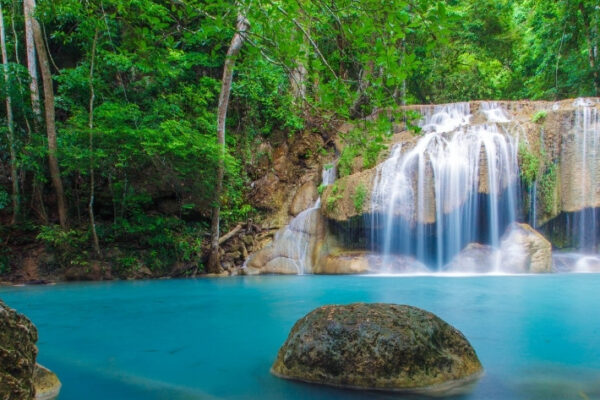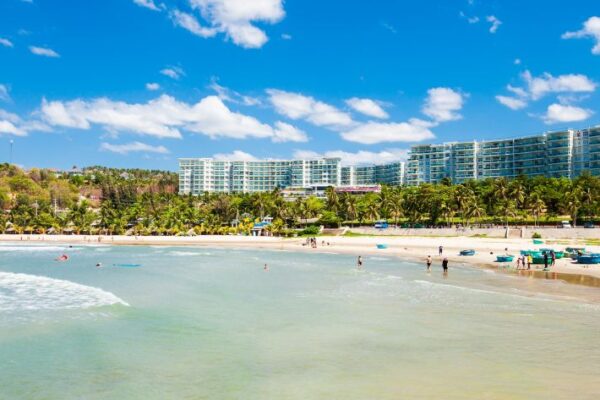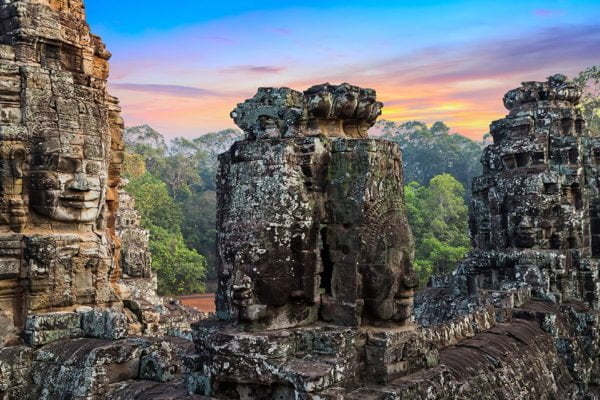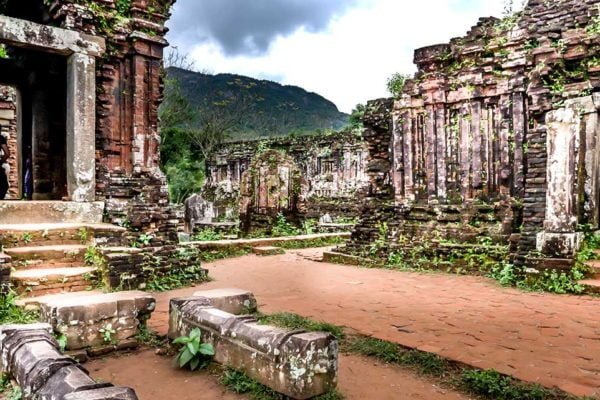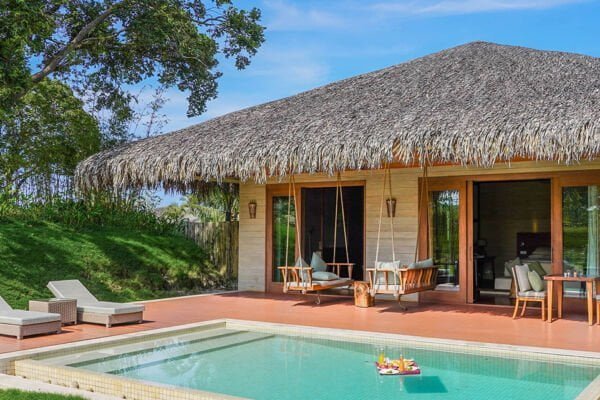Important Landmarks in Southeast Asia for Your Unique Vacation Choices
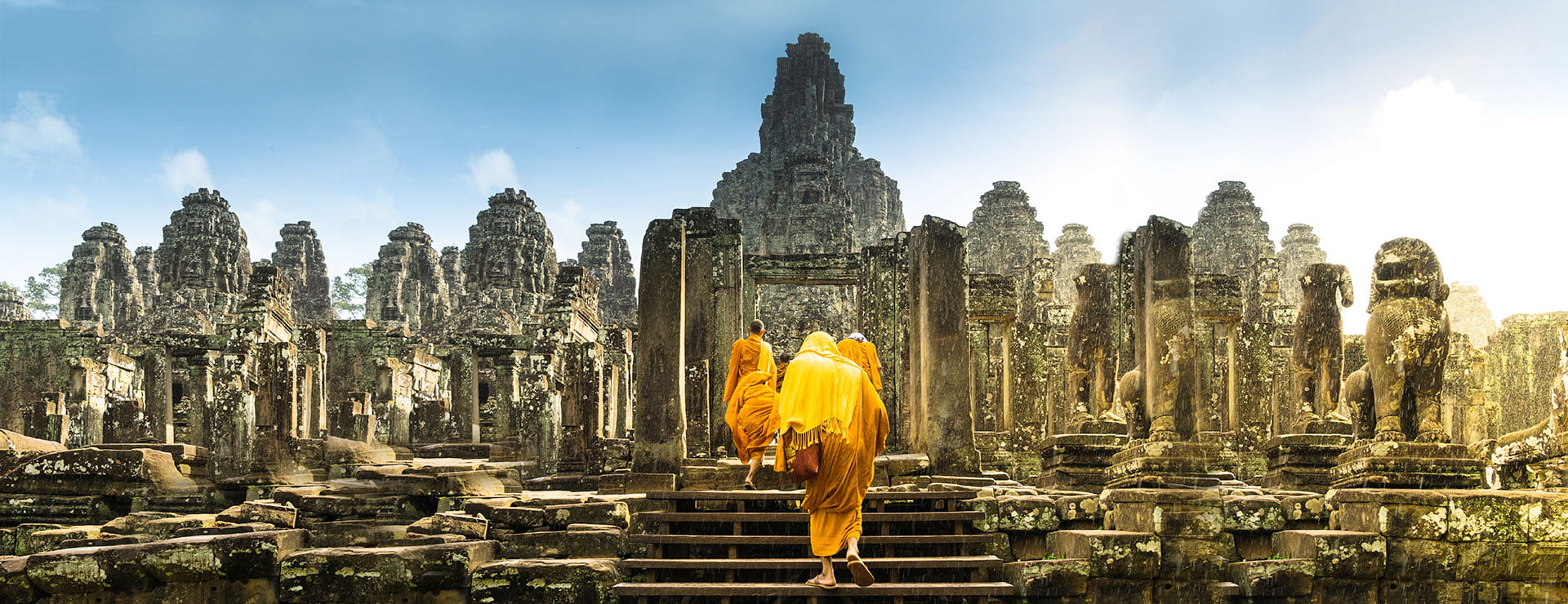
Each nation in Southeast Asia reflects both its deep-rooted traditions and the pulse of contemporary city life. Scattered across these lands are mysterious landmarks worth exploring. Come to visit landmarks in Southeast Asia and you’ll understand why they stand as enduring symbols of their nations.
Cultural & Historical Landmarks in Southeast Asia
Lung Cu Flag Tower (Vietnam)
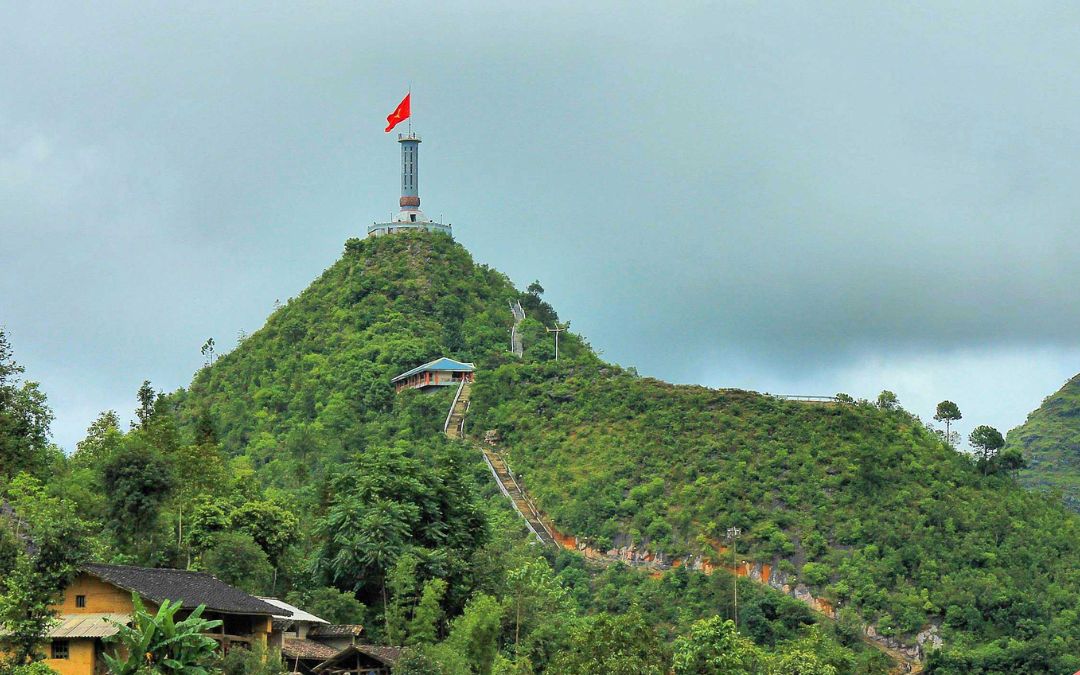
This Vietnam’s northernmost point is one of the most patriotic landmarks in Southeast Asia.
At the very tip of northern Vietnam, on the summit of Dragon Mountain in Ha Giang, stands the Lung Cu Flag Tower—a landmark that combines breathtaking scenery with profound national significance. Perched at nearly 1,700 meters above sea level, this tower marks the northernmost point of the country, a place where history, culture, and landscape intertwine.
What to Observe & Experience
- Tower Architecture & Symbolism
The tower stands at approximately 33.15 m in height and 3.8 m in diameter, with an octagonal base. The flagpole supports a national flag covering 54 m², symbolizing the unity of Vietnam’s 54 ethnic groups. The walls are detailed with reliefs inspired by Dong Son bronze drum motifs, and stone or bronze carvings showing historical eras and the customs of the ethnic minorities in Ha Giang.
- The Climb & The Views
The ascent involves stone staircases, both outside and inside the tower. From parts of the path, you can already start glimpsing sweeping valleys, terraced fields, and clusters of ethnic minority villages. At the summit, the panorama opens up to the Dong Van Karst Plateau, distant peaks (on clear days, even parts of the Chinese border), and the two lakes at the foot of Dragon Mountain known locally as the “Dragon’s Eyes”.
- Cultural & Historical Resonance
This site carries stories of sovereignty, border history, and ethnic life in Vietnam’s highlands. The flag tower has been rebuilt and enlarged through time, but its essence remains — a marker of territory and identity. At its base, the commemorative house displays tools, costumes, and crafts of the ethnic groups of Ha Giang — offering a glimpse into everyday life in these highlands.
Practical Notes:
- This site is usually approached via Dong Van town, taking hours of travel over good-but-winding mountain roads. From the car park (near the mid-slope), a series of external stone steps lead upward, then a spiral staircase inside the tower brings you to the top.
- Clear skies and best visibility tend to happen in spring (March–May) and autumn (September–November). These seasons bring mild weather and dramatic landscapes. Avoid the peak of the rainy season if possible, as the roads can get slippery and the view hazy.
- Comfortable walking shoes are essential. Bring water, layers of clothing (it can get cold up high, especially in mornings or late afternoons). Also, have some cash on hand as border regions often have limited infrastructure for digital payments. Respect local customs, especially in nearby villages.
>> Read More: How to Plan the Perfect Northern Vietnam Tour – Culture, Nature & Local Charm
Angkor Wat (Cambodia)
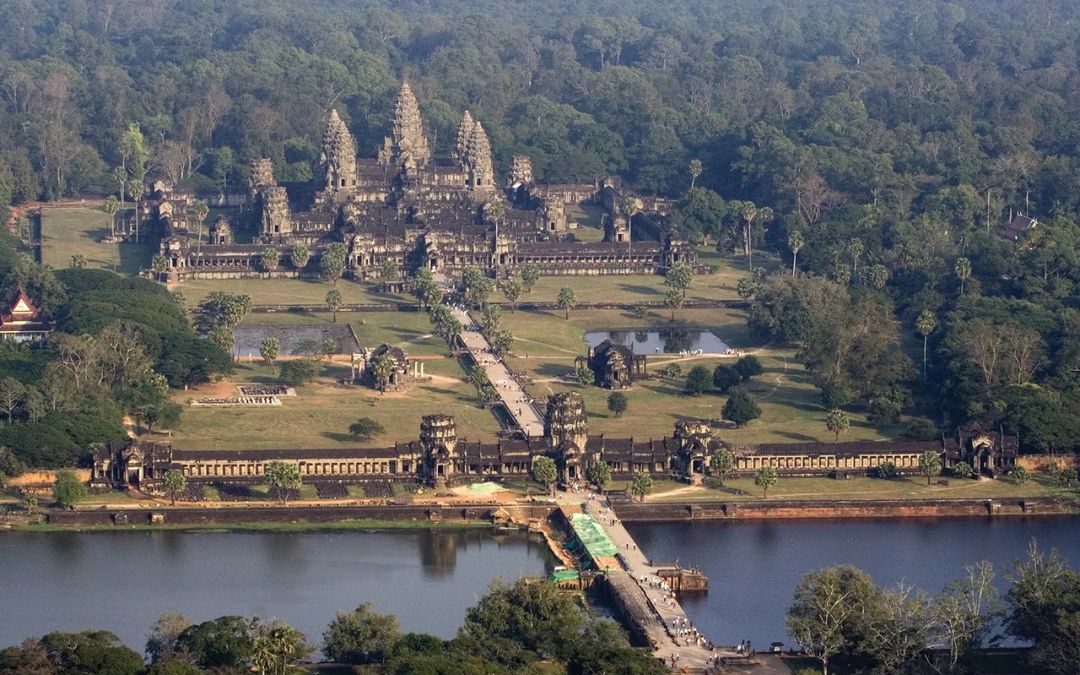
The pinnacle of ancient Khmer architecture and spiritual devotion.
Tucked into the forests north of Siem Reap, Angkor Wat is a place where history, mythology, and artistry meet on a monumental scale. Built in the 12th century under King Suryavarman II, this vast temple complex began as a Hindu sanctuary to Vishnu and later became one of the most important Buddhist landmarks in Southeast Asia. Today it stands as the largest religious monument on earth and a lasting symbol of Cambodia’s cultural heart.
What to Observe & Experience
- Architectural Harmony & Layout
The complex is surrounded by a vast wall (about 3.6 km long) and a wide moat, framing three successive galleries, each rising above the last. At its heart stands a quincunx of towers—one central spire surrounded by four corner towers—which mirror Mount Meru in Hindu cosmology.
- Bas-Reliefs & Storytelling in Stone
Along the inner walls of Angkor Wat’s outer gallery stretch large, richly detailed bas-relief panels (over 1,200 square meters) depicting scenes from the Ramayana, Mahabharata, as well as mythological episodes like the Churning of the Sea of Milk.
Also present are carvings of daily life under the Khmer Empire and countless devata (guardian spirits or celestial figures) and apsaras (heavenly dancers), each rendered with subtle differences in posture, dress, and ornamentation.
- Material, Engineering & Orientation
Mostly built from sandstone, with laterite used in foundations. Many of the intricately carved blocks were transported from Phnom Kulen mountain, some 50 km away, using rivers and canals. Interestingly, unlike most Khmer temples, Angkor Wat faces west—a direction that some scholars believe relates to funerary or solar symbolism.
- Survival & Continuous Significance
Though built over 900 years ago, the temple has never been fully abandoned. It transitioned from Hindu worship to Theravada Buddhism in later centuries. While much of the surrounding Angkor complex saw decline, Angkor Wat retained religious importance, which helped with its preservation.
Practical Notes
- Arriving before dawn rewards with one of the most iconic sunrise moments anywhere: the temple silhouette reflected in still waters as light slowly reveals its spires.
- Wander slowly through the galleries, paying attention to the stories carved in bas-relief and try tracing a full scene from beginning to end, wall by wall.
- Wear comfortable shoes as stepping up terraces and navigating narrow galleries requires steady footing. Early morning or late afternoon are both cooler and softer.
>> Read More: The Best Way to See Angkor Wat – A Local Guide’s Step-by-Step Plan
Borobudur (Indonesia)
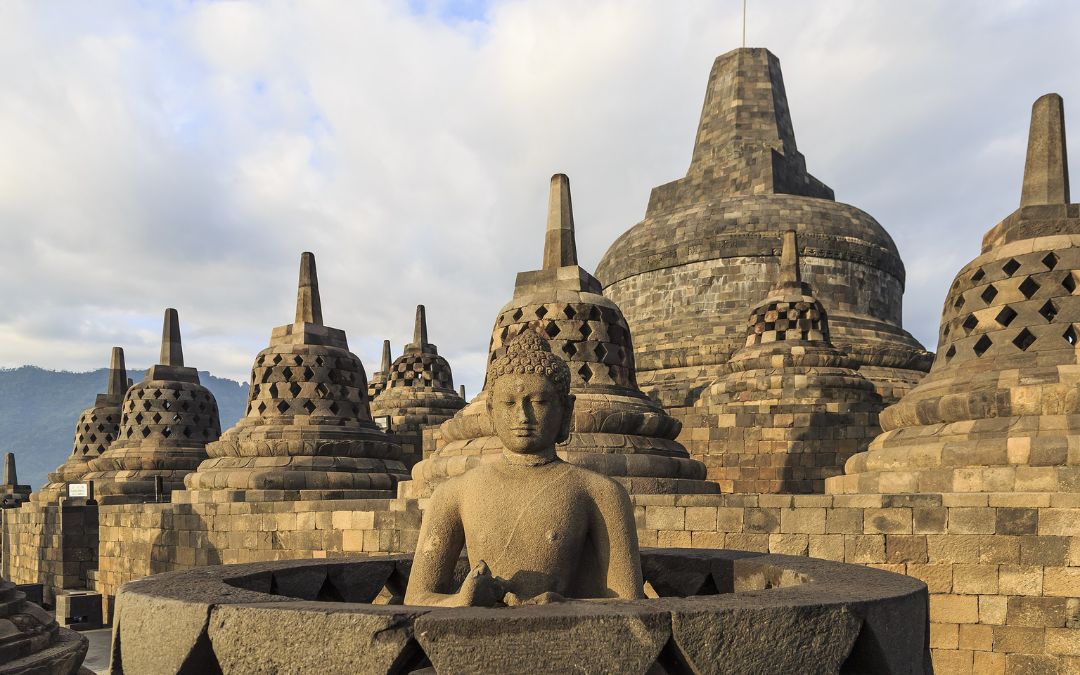
Stone carvings and terraced mandala design showcase ancient Javanese craftsmanship.
Rising from the heart of Central Java, Borobudur is the world’s largest Buddhist temple complex—a place where artistry, devotion, and history meet in one monumental experience. Built in the 9th century under the Shailendra Dynasty, the temple was conceived as a three-dimensional mandala, guiding pilgrims through stages of spiritual awakening.
What to Observe & Experience
- Layered Platforms: Borobudur consists of nine stacked platforms—six square and three circular platforms—topped by a central dome. The design represents the journey from the earthly realm to enlightenment.
- Symbolic Cosmology: Each level corresponds to Buddhist cosmology—Kāmadhātu (desire), Rupadhātu (forms), and Arupadhātu (formless), guiding pilgrims along a path of spiritual ascent.
- Stones & Structure: Constructed from over two million volcanic stone blocks without mortar, the interlocking stones have withstood centuries of weather while supporting intricate carvings.
- Extensive Carvings: The temple walls feature over 2,600 relief panels, illustrating the life of Buddha, Jataka tales of his past lives, and moral teachings rooted in karma.
- Buddha Figures: Originally home to more than 500 Buddha statues, 72 remain seated within perforated stupas on the upper terraces, symbolizing enlightenment and serenity.
- Storytelling in Stone: From apsaras to depictions of daily life in 9th-century Java, each carving brings history and spirituality to life.
Practical Notes
- Arrive early in the morning to experience the mystical sunrise and watch mist rise over the surrounding hills.
- Wear comfortable shoes for climbing terraces and navigating steps, and dress modestly to honor the site’s sacredness.
- Follow the reliefs methodically or hire a guide to deepen understanding of the temple’s history, symbolism, and cultural context.
Bagan (Myanmar)
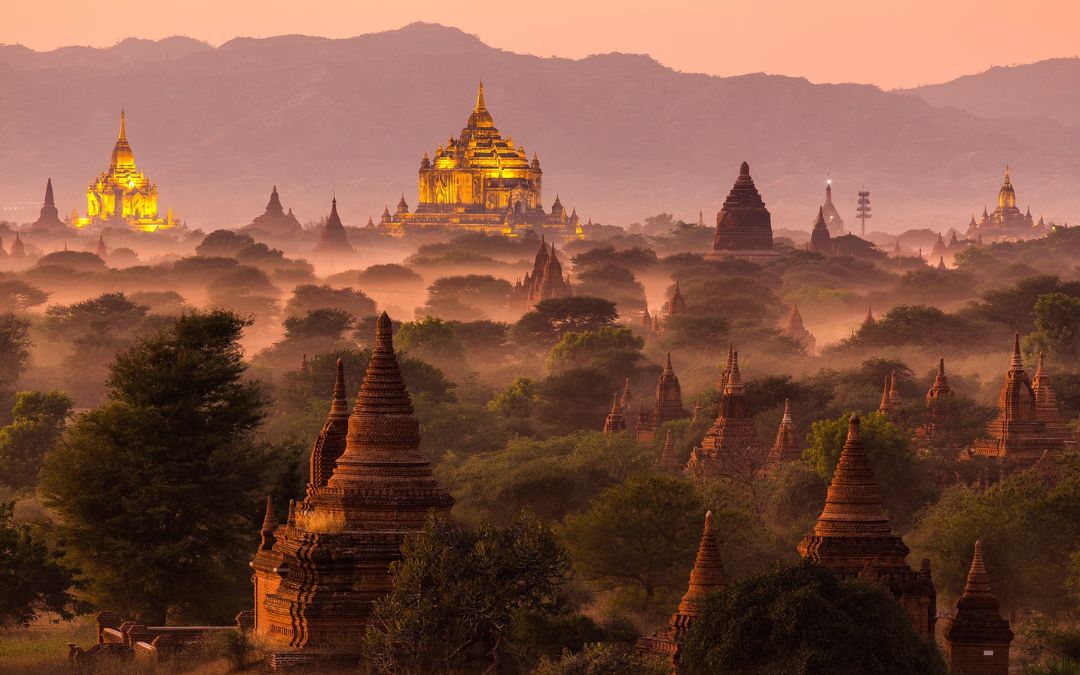
Bagan’s vast temple plains showcase centuries of Buddhist architectural mastery.
Stretching across the central plains of Myanmar, Bagan is among landmarks in Southeast Asia where history and spirituality meet beneath an endless sky. Once the capital of the Pagan Kingdom from the 9th to the 13th centuries, it became one of Asia’s great centers of Buddhist learning and devotion.
At its peak, more than 10,000 temples, stupas, and monasteries rose here. Though time and earthquakes have left their mark, over 2,000 still stand, earning Bagan recognition as a UNESCO World Heritage Site in 2019.
What to Observe & Experience
- The Rise of the Pagan Kingdom
Bagan marked the dawn of the first unified Burmese empire. As Buddhism spread, rulers and wealthy patrons poured resources into constructing temples and pagodas, transforming the plains into a sacred hub of devotion. At its height, the city was not only a political capital but also a center of learning, attracting monks and scholars from across Asia.
- Endurance through Time
Earthquakes and invasions left their mark, yet thousands of structures remain—some restored, others gracefully weathered—standing as symbols of resilience and faith that have carried through nearly a millennium.
- Blending Traditions
The temples of Bagan reveal a mix of Pyu, Mon, and Indian influences, with innovations such as vaulted interiors and elegant spires that influenced temple design throughout Southeast Asia.
- Sacred Artistry
Stucco carvings, murals of Jataka tales, and gilded stupas reflect both the artistry and the spiritual devotion of their time. Exploring them offers insight into how architecture was used not only as worship but also as a way to teach Buddhist philosophy.
Highlighted Temples
- Ananda Temple: Often called the “Westminster Abbey of Burma”, this elegant temple combines Mon and Indian elements, with gilded spires and four massive Buddha statues facing each cardinal direction.
- Dhammayangyi Temple: Known for its sheer size and precision brickwork, this unfinished structure is shrouded in legends of its ruthless builder, King Narathu.
- Bupaya Pagoda: A riverside stupa dating back to the 9th century, rebuilt after an earthquake but still revered as a symbol of continuity, now shimmering with golden light at sunset.
Practical Notes
- Sunrise and sunset are the most evocative times to wander or gaze across the plains. As the mist lifts in the early morning or the sky glows at dusk, thousands of temples reveal themselves in a dreamlike panorama.
- Hot air balloon rides provide sweeping views, floating silently above the landscape, while renting an e-bike or bicycle offers the freedom to stop at hidden temples, wander through villages, and experience Bagan at your own pace.
- The area is expansive, so comfortable attire and sun protection are essential. Local guides can add depth by sharing legends and historical context that bring the ruins to life.
Ayutthaya (Thailand)
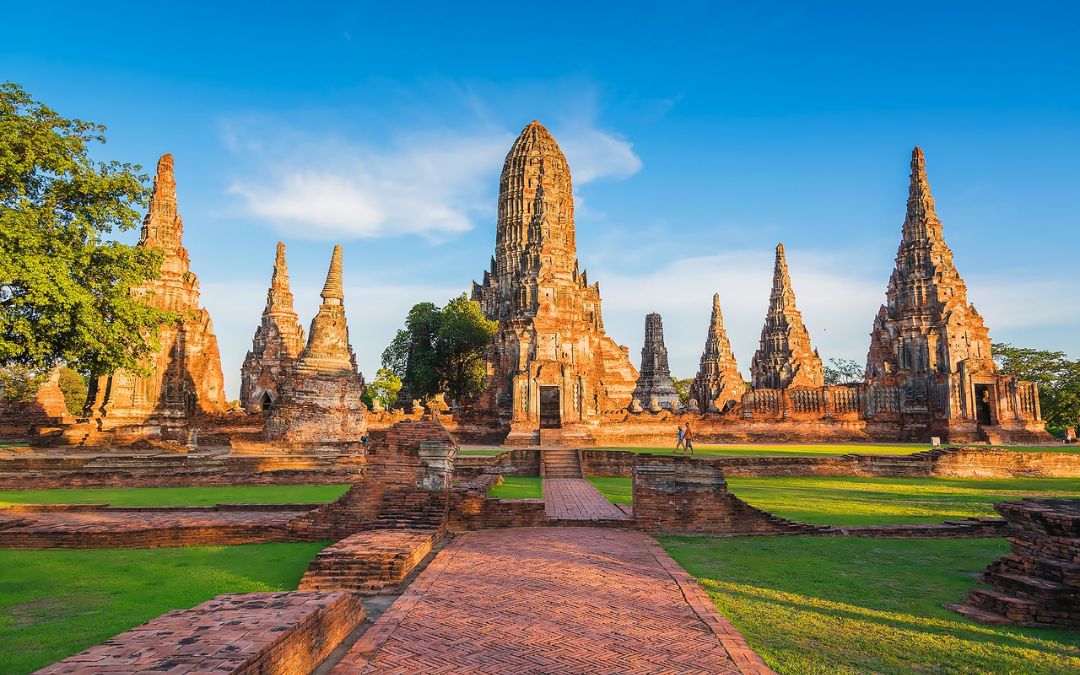
Ayutthaya’s ancient temple ruins preserve the architectural legacy of Siam’s former royal capital
Nestled roughly 80-90 km north of modern Bangkok, Ayutthaya was founded in the mid-14th century (around 1350–1351) by King U Thong, and soon became the second capital of Siam after Sukhothai. Over the next four centuries it grew into a cosmopolitan hub, where palaces, temples, foreign traders, diplomats, and scholars mingled.
After being sacked by the Burmese in 1767, Ayutthaya was never fully restored, but its ruins now sketch a powerful image of past grandeur and draw visitors who want more than just history.
What to Observe & Experience
- Royal and Sacred Architecture
Ayutthaya’s ruins include grand temples (wats), imposing prang towers (those steep, ornate shrines), expansive monasteries, and palaces. For example, Wat Phra Si Sanphet, the former royal temple, once housed three great chedis (stupas) visible across the city. Nearby, Wat Mahathat is famous for its iconic Buddha head wrapped in tree roots. These structures hint at the city’s spiritual and political heart.
- A Crossroads of Trade and Culture
Despite being inland, Ayutthaya became a major trading post linked upstream and downstream by the Chao Phraya, Lopburi, and Pa Sak rivers. Foreign merchants from China, Japan, Persia, Portugal, the Netherlands, and France had enclaves here. Cultural styles and art forms blended—local Buddhist traditions merged with influences brought by foreign craftsmen and travelers.
- City Layout and Strategic Island Geography
The old city sat on an island formed by the meeting of three rivers. Canals, roads, moats, and waterways were used not only for transport and trade, but also for defense and flood control. Its position offered natural protection, and its urban plan reflected a sophisticated vision combining utility and beauty.
Practical Notes
- Morning light or late afternoon brings soft illumination to stone ruins. Cooler hours make exploring more comfortable.
- One of the most peaceful ways to absorb Ayutthaya’s atmosphere is from the water. Floating past temple silhouettes, seeing reflections in the river, and watching daily life along the shore all offer a different perspective than walking.
- Visiting several wats in one day reveals diversity—in size, decoration, and state of preservation. Some of these landmarks in Southeast Asia have vivid murals, others are skeletal, overgrown, and atmospheric. Slow walking means time to pause, reflect, and imagine.
>> Read More: Unlock Spiritual Thailand Temple Tours With The Best Stunning Places Of Worship
Unique & Modern Landmarks in Southeast Asia
Landmark 81 (Vietnam)
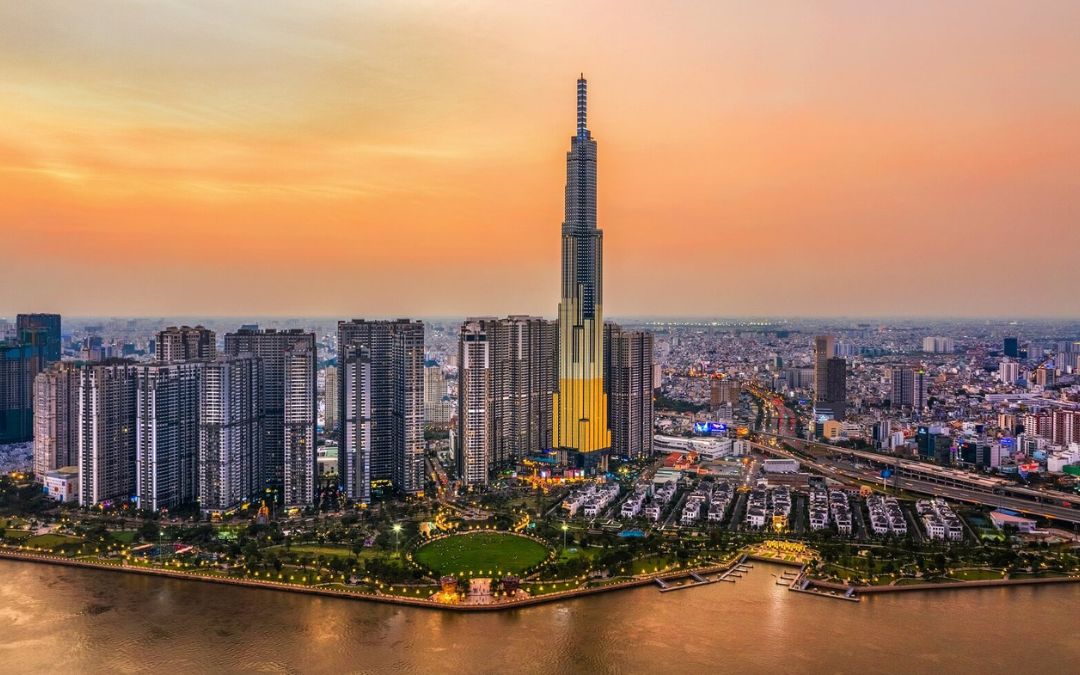
Landmark 81’s towering presence along the Saigon River defines Vietnam’s modern architectural achievement.
Rising gracefully on the banks of the Saigon River, Landmark 81 has quickly become one of Vietnam’s most striking symbols of progress. Completed in 2018, this 461-meter skyscraper isn’t just the tallest building in the country, it’s a vertical city that combines luxury living, world-class leisure, and some of the most breathtaking views of Ho Chi Minh City.
What Makes It Special
- Mixed-Use Marvel
Rather than being just an observation tower, Landmark 81 houses more than eighty floors of function. Lower levels are devoted to the Vincom Center mall with shops, cinema, and dining. Mid-sections include high-end apartments and a luxury hotel (Vinpearl Autograph Collection) occupying floors 47-77.
- Design & Inspiration
The architecture takes cues from bamboo shoots—a culturally resonant symbol of growth and resilience—wrapped in modern glass and steel that reflect sunlight and city lights alike.
- SkyView Observation Deck
On floors 79-81 (~370–383 meters high), the deck delivers sweeping 360° views. The 79th floor hosts a coffee lounge, the 80th features experiences like a virtual-reality “Top of Vietnam” game, and the 81st is an open-air terrace called “SkyTouch”, letting you feel the height and hum of the city beneath.
Practical Notes
- Sunset is particularly magical—watch as Ho Chi Minh City shifts from daylight glow to a galaxy of lights, reflections playing on the Saigon River. Earlier evening hours often offer clearer skies.
- The SkyView deck opens typically from morning into late evening (around 8:30 to 20:00), giving flexibility for morning or golden-hour views.
- Tickets to the SkyView observation floors are more elevated during peak times, so it’s wise to check ahead. Some combo tickets include skydeck + VR experiences.
Marina Bay Sands (Singapore)
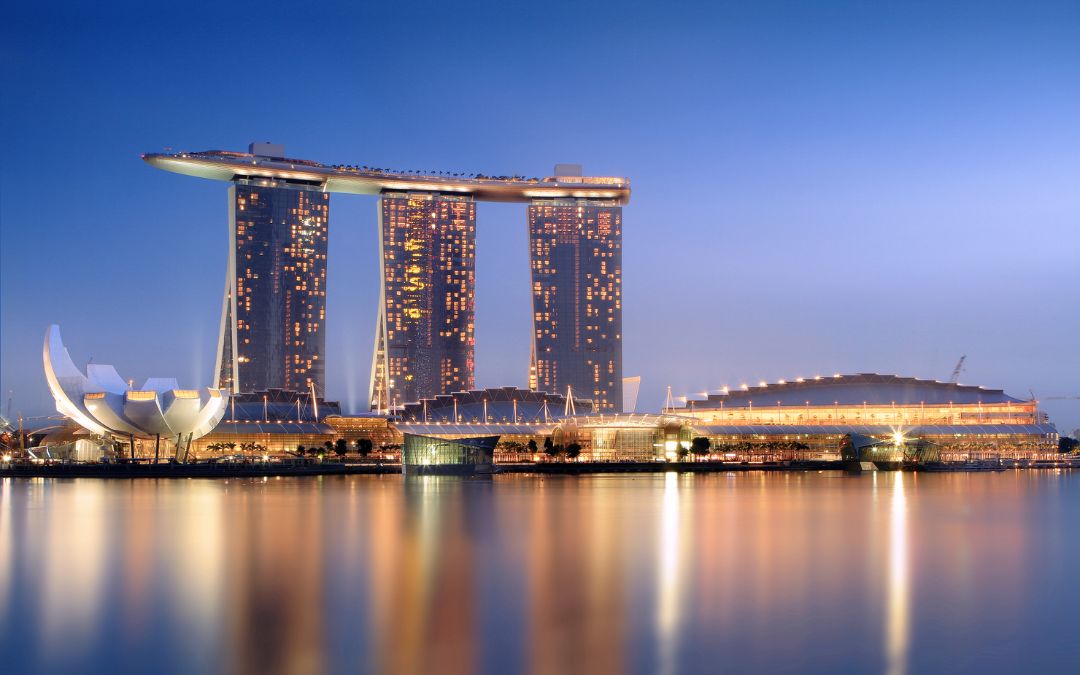
Marina Bay Sands – one of the most recognizable landmarks in Southeast Asia with its distinctive three-tower design and rooftop infinity pool.
Towering over Singapore’s Marina Bay waterfront, Marina Bay Sands stands among landmarks in Southeast Asia as much more than a striking skyline icon—it’s a place where architecture, luxury, and experience quietly converge. Since opening in 2010, this integrated resort has become one of Asia’s most photographed landmarks, not just for its instantly recognizable “ship-deck” SkyPark, but for how it allows visitors to see and feel the city from many different levels.
What Makes It Special
- SkyPark & Infinity Pool
Perched atop three 55-storey towers, the Sands SkyPark spans about 1.2 hectares. It houses the world’s longest elevated infinity pool (~150 m in length), gardens, and rooftop lounges. The public observatory deck (Level 56) gives sweeping views over the bay, Gardens by the Bay, and the city’s skyline.
- Mixed-Use Marvel
Marina Bay Sands combines a lot under one swooping roof: 2,560 hotel rooms; over 120,000 m² of convention and exhibition space; luxury retail (“The Shoppes”); theatre and performance venues; a casino; and the ArtScience Museum with its lotus-inspired shape.
From high above, landmarks like Gardens by the Bay, the Singapore Flyer, the ArtScience Museum, and the waterfront promenade spread below. Evening light shows like Spectra illuminate the bay area, with fountains, lasers, and a light-and-water choreography that’s visible from many vantage points, including up high.
- Design & Engineering Highlights
The SkyPark cantilevers approximately 65-67 meters over the north tower. Its construction involved joining three huge steel plates that bridge across the towers, allowing SkyPark to balance under forces like wind, settlement, and thermal expansion. Gardens, walkways, and trees soften the metal and glass palette.
Practical Notes
- Sunset is especially compelling. As daylight fades, the view shifts: Singapore’s skyline begins to glow, Marina Bay reflects evening lights, and the SkyPark takes on a more intimate mood. Late afternoons or early evenings (just before and after sunset) tend to offer the richest visual transitions.
- The SkyPark Observation Deck (Level 56) is open to the public but tickets are required. The infinity pool on SkyPark (Level 57) is reserved for hotel guests. Even if entrance to the pool isn’t possible, the view from the observation deck gives a strong sense of its drama.
- Booking tickets in advance is wise, especially for peak-sunset slots. Also, being high up means exposure to sun and wind. So, bring layers and maybe a hat, especially if visiting outdoors around sunset.
Petronas Twin Towers (Malaysia)
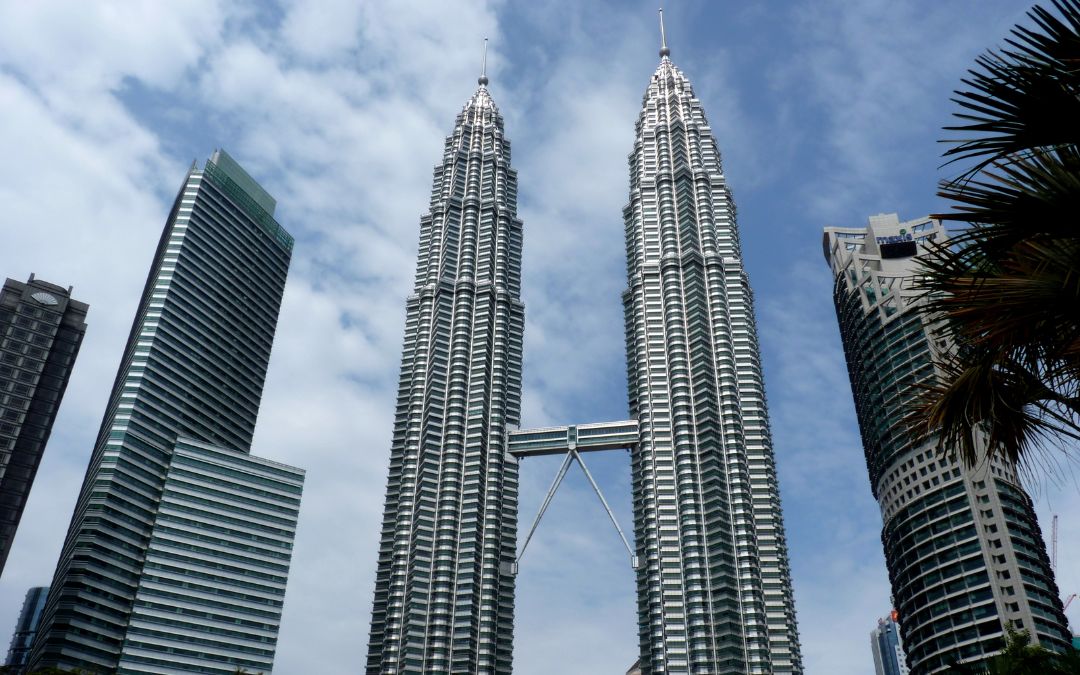
The Petronas Twin Towers feature distinctive Islamic-inspired architecture and a sky bridge connection.
Hoisting above Kuala Lumpur’s skyline, the Petronas Twin Towers are not just a record breaker—they’re among the most famous landmarks in Southeast Asia, whose story is about cultural identity. Completed in 1998 under the design of César Pelli, they rose to 452 meters (including the spires), and though no longer the tallest globally, they remain the tallest twin towers in the world.
What Makes It Special
- Design Rooted in Tradition
The floor plan is shaped from two overlapping squares to form an eight-pointed star, a geometry drawn from Islamic art and symbolic of harmony, unity, and stability. The façades use stainless steel and glass, creating reflections that change through the day.
- Skybridge as Both Link and Lookout
The two towers are connected at floors 41-42 by a double-deck skybridge, sitting about 170 meters above ground. It spans ~58.4 meters, weighs around 750 tons, and isn’t rigidly fixed—it can move a little to deal with wind or sway. This bridge is both functional (evacuation route, inter-tower movement) and dramatic visually.
- Observation Deck & the Heights
On level 86 of Tower 2, the observation deck reaches roughly 370 meters up. From here, city views stretch out across Kuala Lumpur and its surroundings. The deck also features exhibits that tell the story of how the towers were built and what they represent.
Practical Notes
- Access to the skybridge and observation deck is limited as tickets often sell out. Advance booking is highly recommended.
- Visiting in the late afternoon or near sunset can show the towers in changing light—from sharp daytime shadows to soft evening glow, then city lights.
- Bring cameras (look for city panoramas), a light layer (high floors can be breezy). And keep patience as moving between elevators and waiting for access is part of the experience.
Baiyoke Tower II (Thailand)
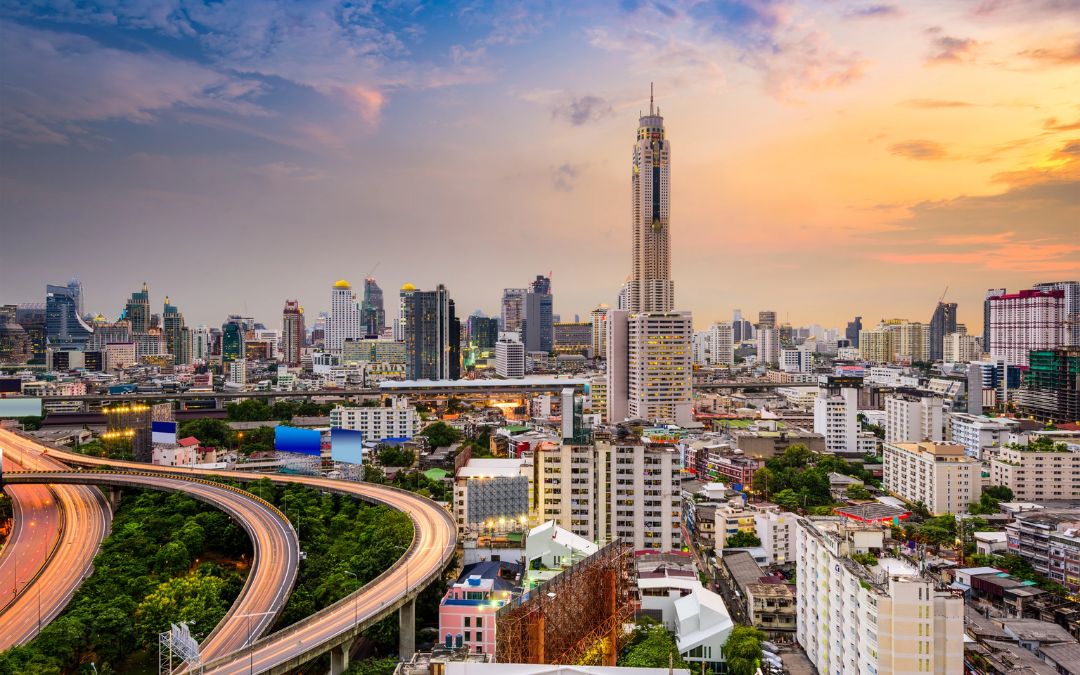
Baiyoke Tower II rises as Thailand’s tallest hotel building with its revolving rooftop restaurant.
Standing 304 meters tall with 84 floors, Baiyoke Tower II has been one of Bangkok’s most recognizable skyscrapers since its opening in 1997. Designed as both a hotel and an observation tower, it represents the city’s growth in the late 20th century while continuing to draw visitors who want to admire the capital from above. Its revolving deck and dining experiences make it more than just a building—it’s among the landmarks in Southeast Asia where the urban sprawl of Bangkok unfolds in every direction.
One of the biggest draws of the tower is its revolving observation deck, which slowly rotates to reveal every angle of Bangkok’s vast cityscape. From this height, the view stretches across the Chao Phraya River, glittering shopping districts, and the sea of buildings that define the metropolis. The experience feels different depending on the time of day, making it a place worth planning around.
What Makes It Special
- 77th-Floor Observation Deck
A glazed, indoor observation area offering sweeping panorama views across Bangkok and beyond. Glass walls, telescopes/binoculars, and informative displays help you pick out landmarks.
- 84th-Floor Revolving Viewpoint / Sky Deck
The highlight for many visitors: an open-air rotating platform, providing 360-degree views without needing to walk around. At night the city lights are especially vivid.
- Restaurants & Dining with a View
Bangkok Sky Restaurant on the 76th & 78th floors: international and seafood buffet, often timed around sunset.
Crystal Grill Dinner Buffet on the 82nd floor: premium steaks, seafood, imported meats, in a refined setting with wall-to-ceiling glass.
- Bars & Nightlife
High-floor bars (for example on or around 83rd floor) offer cocktails plus live music and a chance to unwind while watching Bangkok glow. Some bars have floor-to-ceiling windows or outdoor terrace options.
- Shopping & Market-Style Areas
The tower includes multi-level shopping, especially targeting bargain hunters. Clothing, accessories, souvenirs are available within the building. Also nearby is the Pratunam Market, which complements the more tourist-oriented shopping inside.
Practical Notes
- Late afternoon into evening (around 17:00-18:00) gives a chance to see daylight, sunset, and night lights.
- Some observation decks and restaurants require advance booking, especially for premium or balcony seats or buffet dinners.
- If only going for views, plan on ~1 hour. If including dining, allow 2-3 hours.
- Bring a camera, maybe a layer if wind picks up on open decks, ID for ticket confirmation in some cases.
Final Words
When landmarks in Southeast Asia come to mind, they evoke both timeless culture and vibrant modernity. From ancient temples hidden among emerald landscapes to towering skyscrapers shaping bustling city skylines, each destination offers a story waiting to be discovered and experienced. Now, with a clearer sense of these sites and how to explore them, the journey becomes both manageable and inspiring.
For travelers eager to transform this knowledge into an immersive adventure, reach out Asia Pioneer Travel to craft a path with tailored experiences that reveal the heart and spirit of Southeast Asia in its most remarkable places.
